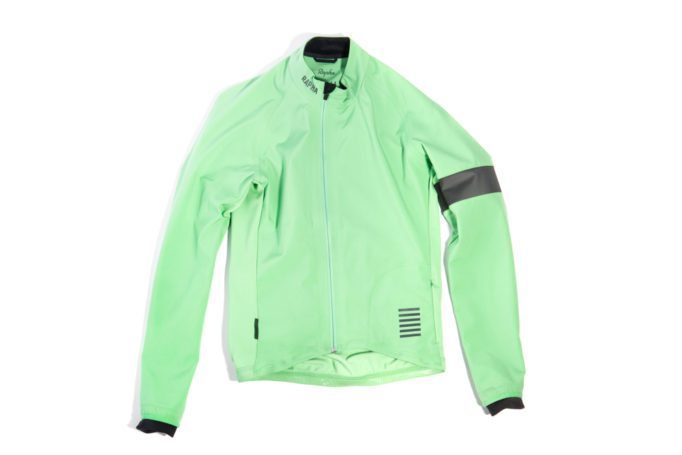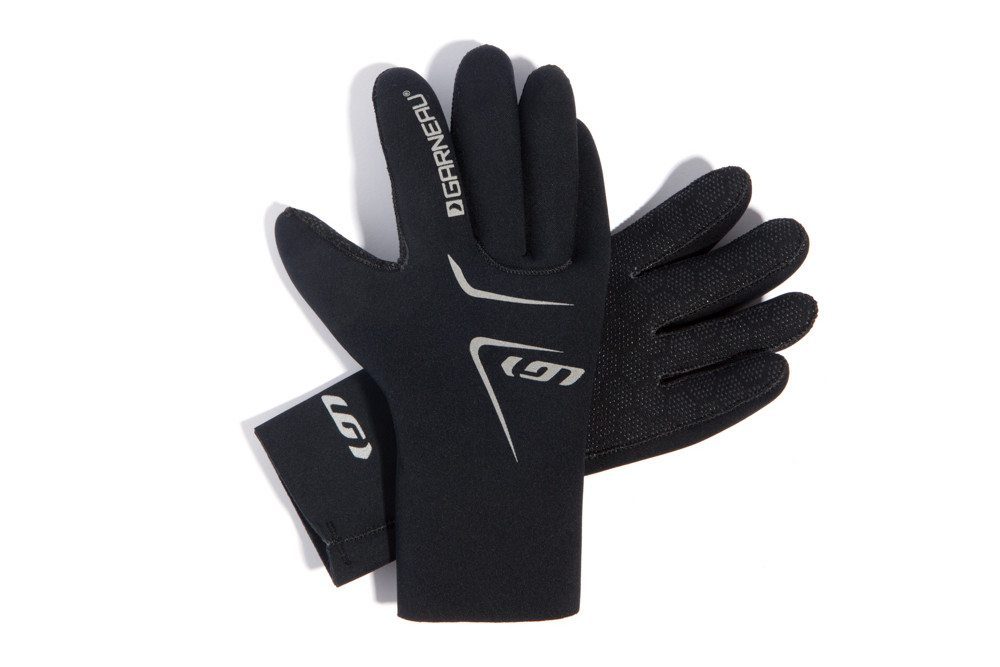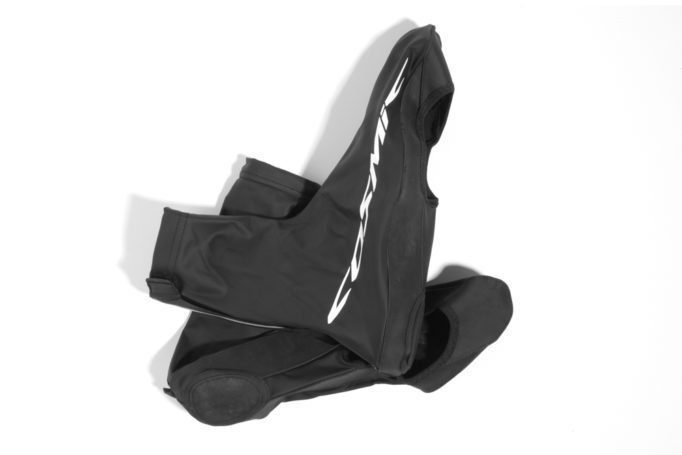Winter Cycling Clothing
The other thing you can grab as a layer is a gilet. The cycling gilet comes in a few different styles, but the style I think works best is the rain gilet. A waterproof rain gilet is less packable but more versatile. The one I really like is the Rapha Pro Team Rain Gilet, and I’ve been wearing the data print version.
When used in warmer weather, you can mix and match with your warmer base layer and your arm warmers to cover a really wide temperature range. If it starts to rain, your core will stay warm and dry because it’s designed for wet weather. The drop tail will do a great job keeping the rest of your kit protected if you are riding without fenders.

The Rapha Pro Team Rain Gilet came a bout after Team Sky riders asked for something waterproof but small enough to fit in their rear pockets
The Rapha Pro Team Rain Gilet, like everything I’ve tried from Rapha, fits absolutely perfectly. It’s really amazing how much nicer the Rapha version fits compared to others I’ve tried. It’s certainly designed for a cyclists body, but if that describes you, then the cut is a dream. Besides how it works as a layer, though, the main reason I’m recommending a rain gilet is that it allows you to pair it with a softshell jacket such as the Rapha Pro Team Jacket.
When I started researching this article, I imagined layering over my summer jersey because that’s what I’d always done. The Rapha Pro Team Jacket changes that equation, though. It’s a jacket that fits like a jersey. Buy it sized like a jersey. It’s definitely a race cut, so you’ll have to decide how that works for your body. And just leave your jersey at home.
It breathes well and works in a wide range of temperatures while also being water-resistant and incredibly comfortable. Then instead of buying a hard shell jacket also, just add your arm warmers and the Rapha Pro Team Rain Gilet. I haven’t actually encountered weather I’d cycle in where the Pro Team Jacket wasn’t warm enough, but I did find that when riding in driving rain, my arms would get cold on the fronts where the rain would pool (Yes, seriously heavy rain- This is Portland.) In those conditions, I appreciated having my arm warmers underneath, and even though the Pro Team Jacket will bead water, it’s not entirely waterproof, so pairing it with the gilet meant that my core was warm and dry.
I don’t know exactly where gloves fit in, but somewhere near the discussion about layered summer gear and driving rain probably makes sense. As it turns out, gloves were actually a really difficult area for me to find the pieces I wanted to recommend. Initially, I was going to recommend the POC AVIP Long Gloves that I reviewed a while ago. They are a really great glove in the fall and spring, and I love the fit.
I was then going to add to that recommendation a pair of Rapha neoprene gloves for really cold and wet conditions. Instead Rapha discontinued their neoprene option, and I ended up with a set of their Pro Team Softshell Gloves instead. The Pro Team Softshell glove doesn’t look like it would be all that versatile, and they almost didn’t make this article even once I had them in for test. They are thin and don’t look like they’d be compatible with a smartphone.

Pro Team Softshell Gloves, “gives both a high level of dexterity and protection against wet and cold conditions” say Rapha
Ever since I grabbed them the first time, though, I’ve reached for them almost every time I’ve needed gloves. What makes them really amazing is that they do a great good job of stopping the wind. Turns out when your hands aren’t being affected by the wind, it doesn’t actually take a ton of insulation to stay warm. And they do actually work on a touch screen. Not as well as the POC gloves, which also aren’t spectacular on a touchscreen, but they get the job done. I don’t know at what point it would get cold enough that you’d want thicker gloves, but I’ve used them down to my 40 degree cutoff, and they worked well. In fact, since they are the same fabric as the softshell jersey, you can even use them quite well in the rain.
For many people, the items I’ve covered up to this point would be enough. For me, though, I ride in heavy rain. No, not just heavy rain, Oregon rain. The kind of rain where I can barely see where I’m going. In this kind of rain, I think it’s worth having a few special items.
For gloves, I’d recommend the Louis Garneau Monsoon Glove. They aren’t even a little bit workable with a smartphone, or even a touch screen cycling computer, they are hard to get on and off, and they are a bit slick on your controls. What they handle really well, though, is keeping your hands warm. You’ll get back from your coldest, wettest, ride, and it’ll feel like your hands have been in a warm bath. That might sound like an odd description, and it is a bit of an odd feeling, but your hands are warm and that’s what really counts. It doesn’t matter how much it rains, or how windy it is, your hands aren’t going to be bothered.
In addition to hands, the other area that really need some extra attention when riding in heavy rain are your feet. One thing that will help are getting some fenders, especially on the front, but in terms of clothing when it’s really coming down, I switch from the Rapha socks to a pair of Showers Pass Crosspoint Waterproof Wool Socks. Just as a torture test, I tried these with no overshoes and no fenders in hard rain and stayed dry for 10 miles. That’s about as good as you’ll get. They are a bit stiff and a bit thick, but they are still pretty comfortable, and they do a good job helping you keep dry. They work well for me but would also be a really great option for cyclocross. I don’t actually wear the Crosspoint socks on their own most of the time, though. What I do is pair them up with a pair of the Mavic Cosmic Pro H20 Shoe Covers.
The Mavic Cosmic Pro H20 Shoe Covers aren’t just a special heavy rain item. They do a good job in heavy rain, but they also help with cold weather and wind. For me, there isn’t any article of clothing that keep my feet from eventually going numb, but I found that the Mavic overshoes gave me at least an additional 30 minutes of feeling in my toes. That might not sound like much, but for me, it’s actually huge.
The way that the Mavic overshoes cover the heel of the shoe does worry me in terms of how long they’ll last, but it’s an effective way of keeping rain and cold from leaking in at the rear of the shoe, and despite my worries, they’ve held up without any issue in the time I’ve used them. They also fit well at the ankle, and the zipper is a high quality piece. If you do any time trialing, you can wear them as an aero aid for racing as well.
As I said though, no piece of clothing keep my toes from going numb. In my informal polling, I’ve found that some people have that problem and other people don’t. It just seems to depend on the person, but if you fall on the side of numb toes, what I recommend is that you pick up a box of chemical warmers. The ones I’ve used are Hot Hands Toe Warmers, and they completely eliminated any numbness. I stuck them to the top of my toes on the outside, where it goes numb first, and the gentle heat, much less than you’d imagine, was just enough to keep things comfortable for a couple of hours at 40 degrees. They are cheap and don’t change the fit of my shoes. Using them means I don’t have to try to insulate my feet quite as much, and that means I get a lot more use out of my Pearl Izumi Thermal Toe Covers. I use them when it’s not raining and not quite cold enough to warrant a full overshoe.
I talked about winter socks, waterproof overshoes, waterproof socks, toe warmers, tights, arm warmers, gloves, neoprene gloves, a softshell jacket, a rain gilet, a hat/neck warmer/balaclava, and chemical toe warmers with the idea being that when paired with your regular summer bibtights and jersey, you can build up a chest of items that can be mixed and matched to cover any weather you are likely to be riding in from fall to spring. It should also cover early morning rides in the summer and should last for years, even as you wear out your bibtights and jerseys.
I spent a lot of time going through the many options available and picking my favorites, but you may already have some of the items discussed or you may have another favorite. Think of this as guide that will help you start your hunt for the things that will keep you warm and comfortable when others have stopped riding. I don’t believe in an off-season, just a change of clothes.
[rps-include blog=127.0.0.1 post=30824]








